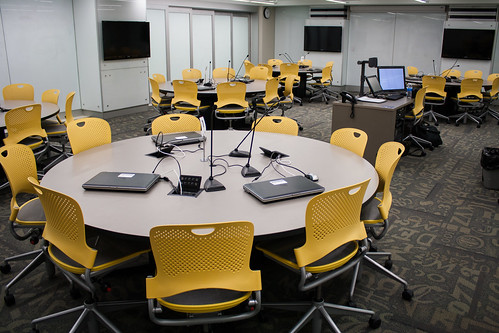Classroom technology can be extremely frustrating. Every room I use seems to have different equipment and controls. Some rooms have old-school wall switches and several remote controls that activate the projectors and screens. Other rooms have a touch screen that controls everything. I tend to get to the room at least 15 minutes before the start of the session, preferably 30 minutes, in case the infrastructure doesn't like me. Sometimes everything just works and I am pleasantly surprised but other times I simply can't work out how to get the system to recognise my laptop or in some cases I can't get the blinds to work. Sometimes there are a row of switches with no indication of what they do and so when I try to turn on a light the black-out curtain starts descending. If all classrooms had the same interface that would be fine but they seem to be all different. This takes up a lot of time and energy from the teacher.
I was therefore pleased to read about a project at Indiana University to create smart classrooms as described in an article in Campus Tech, Are 'Smart' Classrooms the Future?. The vision is to have truly smart classrooms that log you in as you walk in the door and then automatically setting up the lighting, screens, browser, slideshows etc according to your preferences. Students can also log into the room and get access to the necessary resources for the session. No mysterious switches or confusing touch screens to negotiate. If you are going to get teachers to buy into using technology then that technology must make life easier for them and free them from irritatingly time-consuming activities. According to Stacy Morrone, IU associate vice president for learning technologies:
"We want to free up faculty from many of the routine tasks they need to complete during every class period to give them more time to interact with their students, starting from the moment they walk into the classroom."
IU invited a number of stakeholders to participate in a working group to brainstorm ideas for realising the smart classroom of the future. Their conclusions can be found in a report, the Indiana University Smart Classroom Summit. Among the ideas was to have smartboard functionality on walls and tables so that students could write and draw anywhere and be able to save everything digitally. Most importantly the technology should become invisible and biometrically or voice-activated.
Even more interesting would be to have classrooms that are designed to fully integrate distance students into the class with smart microphones and cameras that track whoever is speaking in the room as well as allowing distance students to contribute seamlessly. The vital element here is that the online participants are always visible and can participate in all activities. This could mean that they can be assigned to work in a group with classroom students or working as an online group but contributing to the common work spaces shared by the whole class. In today's classrooms the online students are usually passive spectators.
I look forward to walking into my first smart classroom where everything just works.
I look forward to walking into my first smart classroom where everything just works.

No comments:
Post a Comment
Note: Only a member of this blog may post a comment.